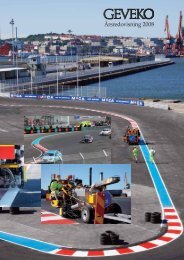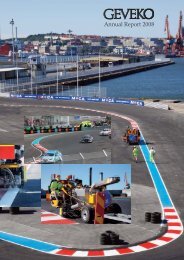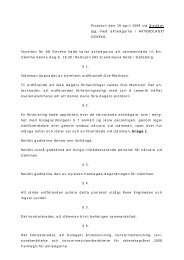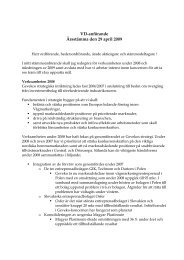PDF Document 2.46 MB - Geveko
PDF Document 2.46 MB - Geveko
PDF Document 2.46 MB - Geveko
You also want an ePaper? Increase the reach of your titles
YUMPU automatically turns print PDFs into web optimized ePapers that Google loves.
Financial Reports / Accounting and valuation principles2) hedging of a very likely forecast transaction(cash flow hedge); or3) hedging of a net investment in a foreignsubsidiary.If the derivative has been identified as ahedge the Group makes a record of whenthe transaction takes place, of the relationshipbetween the hedge and the hedgeditem, as well as of the purpose of the hedge,and the strategy upon which various typesof hedging action are based. The Group alsorecords its assessment, when entering intothe hedging contract and regularly thereafter,of the extent to which the derivativeinstruments used for hedging are effective inoffsetting changes in the fair value or cashflow associated with hedged items.The Group currently uses hedgeaccounting to reduce the currency risk associatedwith net investments in foreign businesses.The hedges used are loans in thecurrency in question. Profits and losses onhedges that are attributable to the effectivepart of the hedge are stated in equity, profitor losses attributable to the ineffective partare stated immediately in the profit andloss account. Accumulated profits andlosses in equity are stated in the profit andloss account when the foreign business isdivested.The Group also uses derivatives toreduce the risks associated with theSecurities Portfolio. Changes in the value ofsuch derivatives are stated without the useof hedge accounting direct in the profit andloss account where they match changes inthe value of the Securities Portfolio, whichare also stated direct in the profit and lossaccount.Inventories IAS 2Inventories are valued using the first in firstout principle at the lower of their historiccost and closing net sales value. Homo ge -neous product groups are valued collectively.The historic cost comprises all costsrelating to purchasing, production costs andother costs incurred in bringing the productto its condition and position on the closingday.The net sales value is the estimatedsales price for an asset between knowledgeableparties who are independent of eachother and who have an interest in carryingout the transaction. Deductions shall bemade for selling costs and settlement.Reporting by segment IAS 14Lines of business contain products or servicesthat are subject to risks and returns thatdiffer from other lines of business. Geo -graphical markets supply products or serviceswithin a specific economic environment thatis subject to risks and returns that differ fromthe risks and returns that apply to unitsactive in other economic environments. Inthe Group, Industrial Operations andManagement of Securities are classified asprimary segments, and the geographicalregions within Industrial Operations assecondary segments.Industrial Operations consists of twolines of business: Road Marking and Chem -Tech. They are treated as one business areain the reporting by segment as RoadMarking is invoiced internally for a notinsignificant proportion of ChemTech’s sales,and ChemTech’s operating result and externalsales account for less than 10% of the correspondingfigures for Industrial Operations asa whole.Cash-flow analysis IAS 7The cash-flow analysis is drawn up using theindirect method. The cash flow stated in -cludes only transactions that involve receiptsor disbursements.By liquid funds is meant, apart fromcash and bank deposits, short-term financialplacements that are exposed only to aninsignificant risk of fluctuations in value, aretraded on an open market at knownamounts, or have a shorter outstandingduration than three months from the dateof acquisition.Remuneration to employees IAS 19The Group has both defined benefit anddefined premium pension plans. Salariedemployees of Swedish companies havedefined benefit plans. The contractual pensionsof other Group employees are of thedefined premium type.A defined benefit plan stipulates whatbenefits the employee will receive afterretirement. They normally depend on age,years of employment, and remuneration paidduring the employee’s active employment.A defined premium plan is a plan inwhich the Group pays an agreed premium,normally to an insurance company. Over andabove this, the Group has no commitmentsto the employee. The premiums are statedamong personnel costs when they fall duefor payment.The Group’s main pension plan forsalaried employees in Sweden is the ITPplan, which is secured by the payment ofpremiums to Alecta. This plan is of thedefined benefit type and includes manyemployers. Alecta has not been able to providesuch information for the 2006 or 2007financial years as would enable the Group totreat the plan as a defined benefit plan. Thepension commitments are therefore stated inaccordance with IAS 19.30 in accordancewith the principles for defined premiumplans. See also Notes 4 and 24.Over and above the defined benefitITP plan secured by payment of premiums toAlecta, the Group has a few, small definedbenefit pension commitments. The liabilitythat is stated in the consolidated balancesheet for defined benefit pension plans is thecurrent value of these commitments on theclosing date after adjustment for non-statedactuarial profits/losses for service duringprior periods.The defined benefit commitments arecalculated annually by independent actuariesusing the projected unit credit method. Thecurrent value of the defined benefit commitmentsis determined by discounting the estimatedfuture cash flow using the interestrate for first-class corporate bonds issued inthe same currency as that in which the pensionbenefit will be paid and with durationsthat are comparable to the pension liabilityin question. Actuarial profits and lossesarising from adjustments and changes inactuarial assumptions made on the basis ofexperience that exceed the higher of 10% ofthe value of the managed assets and 10% ofthe defined benefit commitment, are statedas costs or income over the employee’s estimatedaverage remaining period of employment.All pensions (apart from temporarypensions) are vested, which means they arenot conditional on future employment. Seealso notes 4 and 24.EquityThe Group’s equity has the following components:• The share capital corresponds to the parentcompany’s nominal share capital.• Other injected capital consists of all capitalinjected by shareholders over and aboveshare capital. This includes the legalreserve included in the parent company’saccounts to the extent that it was contributedby the shareholders.• Reserves, include such amounts which areto be taken direct to equity as a consequenceof the rules in IFRS. This categoryincludes, for example, certain revaluationsto fair value and translation differences.• Retained earnings consist of the accumulatedprofits on the Group’s business afterdeduction of dividends. In the parentcompany’s accounts, it includes the legalreserve to the extent that it consists oftransfers from each year’s profit.• Minority interests are stated as part ofequity.• In the parent company accounts, equityhas two headings in compliance with therules in the Annual Accounts Act, namelyRestricted equity and Non-restricted equity.63
















